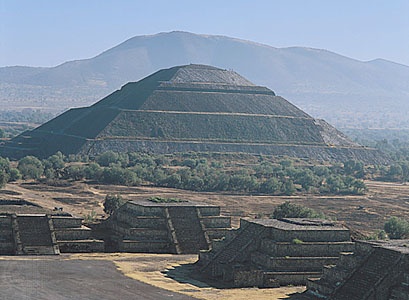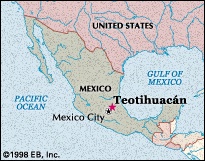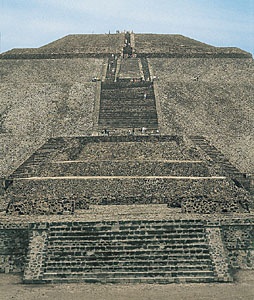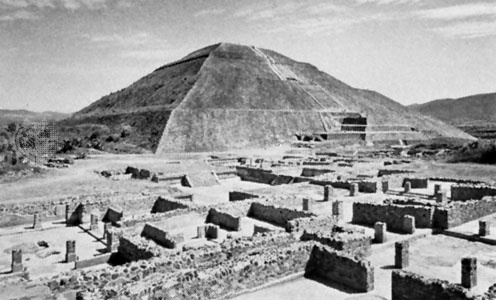Teotihuacán
ancient city, Mexico
Nahuatl“The City of the Gods”


the most important and largest city of pre-Aztec central Mexico, located about 30 miles (50 km) northeast of modern Mexico City. At its apogee (c. AD 500), it encompassed some 8 square miles (20 square km) and supported a population estimated at 125,000–200,000, making it, at the time, one of the largest cities in the world. It was the region's major economic as well as religious centre. Teotihuacán was designated a UNESCO World Heritage site in 1987.
The area was settled by 400 BC, but it did not experience large-scale urban growth until three centuries later, with the arrival of refugees from Cuicuilco, a city destroyed by volcanic activity. It is not known whether the basic urban plan also dates to that time. About AD 750 central Teotihuacán burned, possibly during an insurrection or a civil war. Although parts of the city were occupied after that event, much of it fell into ruin. Centuries later, the area was revered by Aztec (pre-Columbian civilizations) pilgrims.
The origin and language of the Teotihuacanos are yet unknown. Their cultural influences spread throughout Mesoamerica, and the city carried on trade with distant regions. Perhaps two-thirds of the urban population were involved in farming the surrounding fields. Others worked with ceramics or obsidian, a volcanic glass that was used for weapons, tools, and ornamentation. The city also had large numbers of merchants, many of whom had immigrated there from great distances. The priest-rulers who governed the city also staged grand religious pageants and ceremonies that often involved human sacrifices.
In addition to some 2,000 single-story apartment compounds, the ruined city contains great plazas, temples, a canalized river, and palaces of nobles and priests. The main buildings are connected by a 130-foot- (40-metre-) wide road, the Street of the Dead (“Calle de los Muertos”), that stretches 1.5 miles (2.4 km); oriented slightly east of true north, it points directly at the nearby sacred peak of Cerro Gordo. The Street of the Dead was once erroneously thought to have been lined with tombs, but the low buildings that flank it probably were palace residences.
The north end of the Street of the Dead is capped by the Pyramid of the Moon and flanked by platforms and lesser pyramids. The second largest structure in the city, the Pyramid of the Moon rises to 140 feet (43 metres) and measures 426 by 511 feet (130 by 156 metres) at its base. Its main stairway faces the Street of the Dead.
 Along the southern part of the avenue lies the Ciudadela (“Citadel”), a large square courtyard covering 38 acres (15 hectares). Within the Citadel stands the Temple of Quetzalcóatl (the Feathered Serpent) in the form of a truncated pyramid; projecting from its ornately decorated walls are numerous stone heads of the deity. The temple walls were once painted in hematite red. Excavations of the Citadel were first carried out during the period 1917–20. Individual burial sites were found around the temple in 1925, and in the early 1980s archaeologists discovered the ceremonially interred remains of 18 men, probably soldiers who had been ritually sacrificed. carbon-14 dating indicated that the graves were prepared about AD 200. Further work has revealed more than 130 skeletons of both sexes in mass graves along the edges of the temple, as well as beneath it.
Along the southern part of the avenue lies the Ciudadela (“Citadel”), a large square courtyard covering 38 acres (15 hectares). Within the Citadel stands the Temple of Quetzalcóatl (the Feathered Serpent) in the form of a truncated pyramid; projecting from its ornately decorated walls are numerous stone heads of the deity. The temple walls were once painted in hematite red. Excavations of the Citadel were first carried out during the period 1917–20. Individual burial sites were found around the temple in 1925, and in the early 1980s archaeologists discovered the ceremonially interred remains of 18 men, probably soldiers who had been ritually sacrificed. carbon-14 dating indicated that the graves were prepared about AD 200. Further work has revealed more than 130 skeletons of both sexes in mass graves along the edges of the temple, as well as beneath it. The Pyramid of the Sun is one of the largest structures of its type in the Western Hemisphere. It dominates the central city from the east side of the Street of the Dead. The pyramid rises 216 feet (66 metres) above ground level, and it measures approximately 720 by 760 feet (220 by 230 metres) at its base. It was constructed of about 1,000,000 cubic yards (765,000 cubic metres) of material, including hewed tezontle, a red, coarse volcanic rock of the region. During hastily organized restoration work in 1905–10, the architect Leopoldo Batres arbitrarily added a fifth terrace level to the structure, and many of its original facing stones were removed. In the early 1970s exploration below the pyramid revealed a system of cave and tunnel chambers. Over subsequent years other tunnels were revealed throughout the city, and it was suggested that much of the building stone of Teotihuacán was mined there.
The Pyramid of the Sun is one of the largest structures of its type in the Western Hemisphere. It dominates the central city from the east side of the Street of the Dead. The pyramid rises 216 feet (66 metres) above ground level, and it measures approximately 720 by 760 feet (220 by 230 metres) at its base. It was constructed of about 1,000,000 cubic yards (765,000 cubic metres) of material, including hewed tezontle, a red, coarse volcanic rock of the region. During hastily organized restoration work in 1905–10, the architect Leopoldo Batres arbitrarily added a fifth terrace level to the structure, and many of its original facing stones were removed. In the early 1970s exploration below the pyramid revealed a system of cave and tunnel chambers. Over subsequent years other tunnels were revealed throughout the city, and it was suggested that much of the building stone of Teotihuacán was mined there. The city was initially excavated in 1884. In the 1960s and '70s the first systematic survey (the Teotihuacán Mapping Project) was led by the American archaeologist René Millon, and hundreds of workers in 1980–82 excavated under the direction of the Mexican archaeologist Rubén Cabrera Castro. Work in the 1990s focused on the city's subterranean tunnels and on the apartment compounds, which were found to be decorated with vividly painted murals. Longstanding threats to the greater area of ruins are posed by human habitation (including five towns), numerous shops, roads and highways, and a military base. Many neighbourhoods excavated in the late 20th century had been earlier cultivated by farmers. See also pre-Columbian civilizations: Teotihuacán. (pre-Columbian civilizations)
The city was initially excavated in 1884. In the 1960s and '70s the first systematic survey (the Teotihuacán Mapping Project) was led by the American archaeologist René Millon, and hundreds of workers in 1980–82 excavated under the direction of the Mexican archaeologist Rubén Cabrera Castro. Work in the 1990s focused on the city's subterranean tunnels and on the apartment compounds, which were found to be decorated with vividly painted murals. Longstanding threats to the greater area of ruins are posed by human habitation (including five towns), numerous shops, roads and highways, and a military base. Many neighbourhoods excavated in the late 20th century had been earlier cultivated by farmers. See also pre-Columbian civilizations: Teotihuacán. (pre-Columbian civilizations)Additional Reading
Janet Catherine Berlo (ed.), Art, Ideology, and the City of Teotihuacan (1992), collects papers on a range of topics from a symposium held in 1988. Studies of skeletal remains are Rebecca Storey, Life and Death in the Ancient City of Teotihuacan: A Modern Paleodemographic Synthesis (1992); and Martha L. Sempowski, Michael W. Spence, and Rebecca Storey, Mortuary Practices and Skeletal Remains at Teotihuacan (1994). Art in the ancient city is discussed in Kathleen Berrin (ed.), Feathered Serpents and Flowering Trees: Reconstructing the Murals of Teotihuacán (1988); Kathleen Berrin and Esther Pasztory (eds.), Teotihuacan: Art from the City of the Gods (1993); and Esther Pasztory, Teotihuacan: An Experiment in Living (1997).
- kapok
- Kapoor, Raj
- Kaposi sarcoma
- Kaposvár
- kappa
- kappa organism
- Kappel Wars
- Kapp, Wolfgang
- Kaprow, Allan
- Kapteyn, Jacobus Cornelius
- Kapuas River
- Kapuni
- Kapurthala
- Kapuskasing
- kapāla
- Karabagh rug
- Kara-Bogaz-Gol Gulf
- Karabük
- Karachay-Cherkessia
- Karadjordje
- Karadjordjević dynasty
- Karadžić, Radovan
- Karadžić, Vuk Stefanović
- Kara-e
- Karaganda